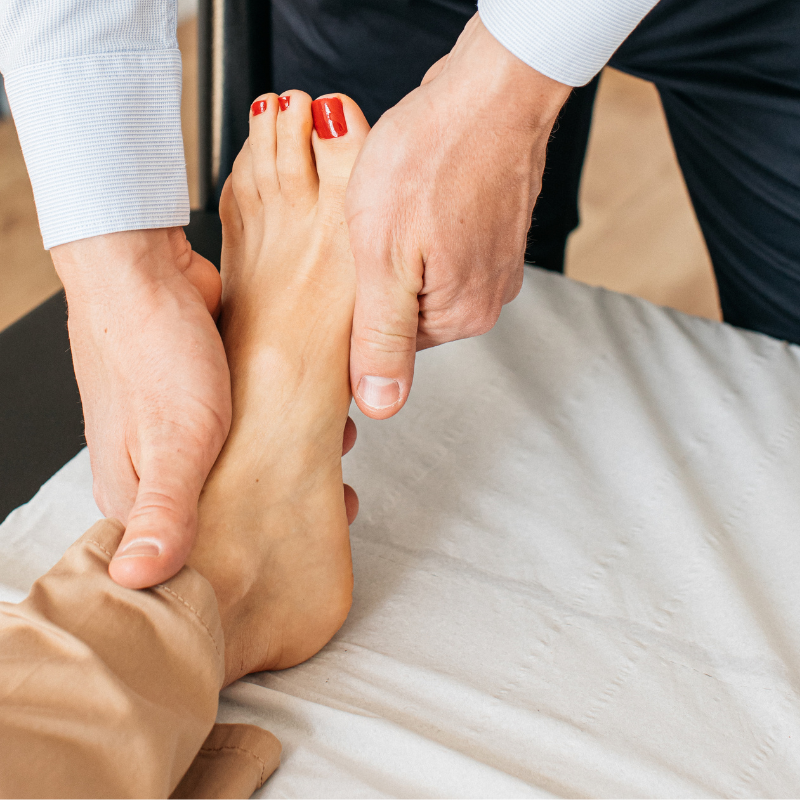Osteopath for Plantar Fasciitis
Struggling with Plantar Fasciitis? Here's How an Osteopath Can Help You Heal Faster
If you're dealing with a stubborn, stabbing pain in your heel or the sole of your foot—especially first thing in the morning or after a long run—you might be suffering from plantar fasciitis. It's one of the most common causes of foot pain and can be incredibly disruptive, especially if you're active or on your feet frequently. However, did you know that an osteopath can do much more than treat pain? At Wellthy Clinic, we take a holistic and personalised approach to recovery, combining hands-on osteopathic treatment, targeted Pilates rehabilitation, and nutritional support to help you get back on your feet—literally. In this blog, we’ll explore the causes of plantar fasciitis, its relationship to factors such as running, footwear, and posture, and why a multidisciplinary approach often yields the best results for long-term recovery.
Osteopath for Plantar Fasciitis
Your plantar fascia is a strong band of connective tissue on the sole of your foot. Which connects from your heel to your mid-foot, supports the arch of your feet and helps to absorb forces when you are running. This can be a common running injury and the best treatment would be from a sports Osteopath London.
What Causes Plantar Fasciitis Flare-Ups?
Plantar fasciitis occurs when the connective tissue that supports the arch of the foot becomes inflamed, causing pain in the heel and arch. Foot pain is the main symptom of this injury, particularly when you are weight-bearing, and it’s tender to touch.
Osteopath for Plantar Fasciitis
Plantar Fasciitis can be caused by a sudden increase in running intensity or mileage. Also, tight leg muscles (calves and hamstrings in particular) cause additional tension on the plantar fascia. In addition, a change in running surface causes an increase in compressive forces going through the foot and osteoarthritis of the knee. Moreover, if you have had a history of inversion ankle strains or ligament strains, it is also essential to consider your footwear with not enough or indeed too much cushioning or support.
Can Osteopathy Help with Plantar Fasciitis?
Yes, it would be worthwhile seeing an osteopath for an assessment, advice and specific exercises to optimise the recovery process. Fascia tissue heals relatively slowly compared to muscle, due to its distinct tissue composition. Therefore, having a rehab plan to reduce your foot pain would be beneficial for your recovery. Osteopathic treatment would involve muscular stretching, joint articulation, and manipulation for your feet, knees, hips, and indeed your whole posture. It may not be your feet that are the cause of the problem, but it could be your hip (for example).
How do I Permanently Get Rid of Plantar Fasciitis?
At Wellthy Clinic, we suggest starting with a structured rehabilitation plan after a sports injury. This may include some hands-on Osteo to reduce your symptoms initially. Then we will look to include specific Pilates rehab exercises and address your nutrition to optimise healing. The combination of stretching and muscular strengthening yields significant results in alleviating symptoms.
What Aggravates Plantar Fasciitis?
Weight-bearing activities such as walking up and downstairs, and running.
Is Walking Bad for Plantar Fasciitis?
No, however, whilst your symptoms are acute, walking will be painful, but this is not doing any harm or damage. As things get better with treatment and rehab exercises, you will experience less pain whilst walking.
What is the Best Therapy for Plantar Fasciitis?
We believe a combination of hands-on Osteopathic manipulative treatment (OMT) and regular Pilates (stretching and strengthening) practice. It may be beneficial to start with a lighter touch initially with Cranial Osteopathy, especially if your pain is very acute, as it could help alleviate your foot pain. Plantar fascitis massage to help reduce muscular tensions and joint pain and gut health advice can also be incorporated into a rehab plan. In our experience, using a combination of therapies yields the best results.
Will My Plantar Fasciitis Ever Go Away?
Yes, although it will take time, having a well-structured rehab plan will make all the difference. Fascia has a different composition from muscle, so it takes longer to heal; however, hands-on Osteopathy, Pilates rehab exercises, and sports massage will help reduce your pain.
Conclusion
You can recover from plantar fasciitis given a well-structured rehabilitation plan and time. An osteopath will assess your posture, joint and muscle movements to identify imbalances and leg length discrepancies. Hands-on therapy to stretch the muscles, articulate joints, manipulate joints (only if appropriate and with consent) and exercise prescription to get you back to training as quickly as possible. Our nutritionist can also advise on musculoskeletal health to optimise healing times.
At Wellthy Clinic, we offer Osteopathy treatments in London and Pilates to support your training and to avoid injury, along with sports injury rehabilitation and Pilates Rehab.
Other running injuries are discussed in Osteopath for running injuries blog. If you’re struggling with Plantar Fasciitis and would like to give Osteopathy a try, you can book a consultation with us here.
Frequently Asked Questions
Can an osteopath help with plantar fasciitis? Yes, osteopaths can treat plantar fasciitis by addressing both the local foot pain and the underlying biomechanical imbalances. Treatment often includes hands-on therapy, stretching, and rehabilitation exercises.
What finally cured my plantar fasciitis? For many, a combination of manual therapy (such as osteopathy), targeted exercises, and footwear adjustments can lead to a full recovery. Addressing contributing factors, such as tight calves or poor posture, is key.
Why won’t my plantar fasciitis go away? If plantar fasciitis isn’t resolving, it may be due to underlying issues such as poor gait mechanics or inadequate rehabilitation. An osteopath can assess your whole kinetic chain and correct these imbalances.
What is the permanent cure for plantar fasciitis? A structured rehabilitation plan that incorporates osteopathic treatment, strengthening exercises, and proper footwear typically leads to a long-term resolution. Preventive care is essential to avoid recurrence.
What exercises should you avoid with plantar fasciitis? Avoid high-impact activities, such as jumping or sprinting, during flare-ups. An osteopath can guide you on low-load exercises that support healing without aggravating the fascia.
Should I limit my walking due to plantar fasciitis? Limit walking only during acute pain phases. Gradual reintroduction, guided by an osteopath, helps maintain mobility while avoiding overload.
What are the best shoes for plantar fasciitis? Supportive shoes with good arch support and cushioning can reduce strain on the plantar fascia. An osteopath can assess your gait and advise on suitable footwear for your foot type.
Can plantar fasciitis be massaged out? Massage can help relieve muscle tension around the foot and calf, but it won't resolve the root cause alone. Osteopaths use a combination of techniques, including soft tissue release, to support healing.
Is it good or bad to massage plantar fasciitis? Gentle massage can improve circulation and ease discomfort, but should be part of a broader treatment plan. Over-massaging or applying deep pressure can worsen symptoms if done incorrectly.
What can be done to ease plantar fasciitis? A blend of osteopathy, stretching tight muscles, strengthening foot and leg structures, and modifying activity levels. Adding Pilates and nutrition support can also enhance recovery.
Matthew is a Structural & Cranial Osteopath, Pilates Instructor with a background in sports science.


